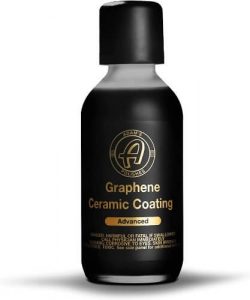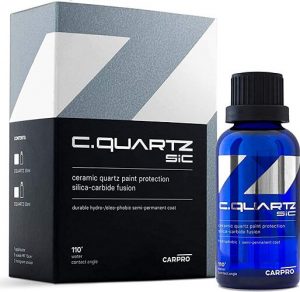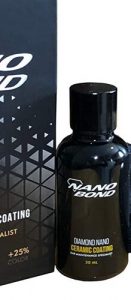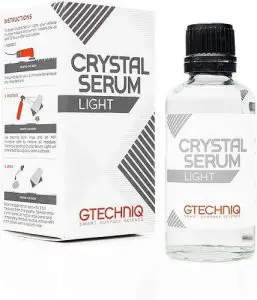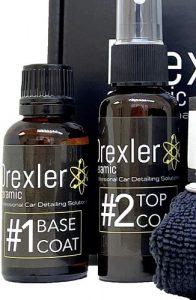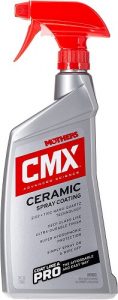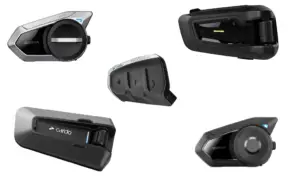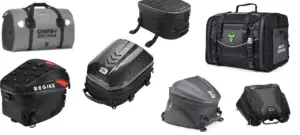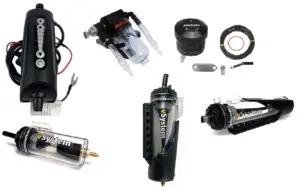Are you looking for a way to protect your motorcycle for the long term, give it a deep, new bike shine, and restore plastic parts to their original condition?
If so, applying a high-quality ceramic coating can help you achieve these goals. Ceramic coatings that contain high concentrations of SiO2, Graphene, or even Titanium will create a hard protective layer over the clear coat of your motorcycle, filling in scratches and improving the reflection properties of the paint.
Additionally, dust, dirt, and water will have a harder time sticking to the smoother surface of a motorcycle that has been ceramic coated, making it less likely to get dirty in the first place. This can save you time on your weekly motorcycle washing routine.
Here are 7 ceramic coating products reviewed.
Contents
Top Picks for the Best Ceramic Coatings 2023
Best overall
#1 Adam’s Graphene Ceramic Coating
- Type: Graphene
- Application: pad + suede cloths
- Compatible Material: paint, plastic, metal
- Cure Time: 24 hrs
- Lasting Time: 7 years (claimed)
- hardness level: 10H
Unique Features
✅ Adam’s coating claims to have a 10H hardness level which is higher than the currently used scale’s maximum at 9H.
✅ 7 years of claimed protection due to the Graphene formula. It is a lot longer compared to other products that use Sio2 (Silicon Dioxide) And Tio2 (Titanium Dioxide) ceramic coating formulas and last 2 years on average. Graphene is considered the next wonder material after all.
✅ Adam’s coating has Ceramic Glow Technology as an application aid, which helps users identify where the coating has already been applied to ensure that no spots are missed. However, this coating should be applied by professionals since misapplication will get costly to remove and will require special tools. For the first-time DIY, I recommend checking other products in this list.
Runner up
#2 CARPRO CQUARTZ SiC Kit
- Type: Silica-Carbide (SiC)
- Application: pad + suede cloths
- Compatible Material: paint, metal
- Cure Time: 12 hours
- Lasting Time: 18 months
- hardness level: 9H
Unique Features
✅ Made with quartz-based nanotechnology. It bonds to paint and metal surfaces.
✅ Has acid and alkyl chemical resistance from 2 pH to 13 pH, improved water spots and minerals resistance, and a high gloss finish.
✅ May be applied at any temperature and has a high slickness and mirror shine surface finish.
best for the money
#3 Nano Bond Ceramic Coating 9H PRO
- Type: SiO2 (80%)
- Application: pad + suede cloths
- Compatible Material: paint, metal, plastic, rubber, windshield
- Cure Time: 3 min during application (24h to fully cure)
- Lasting Time: 3 years
- hardness level: 9H
Unique Features
✅ 80% SiO2 – real high-quality ceramic coating product. Once applied will require polishing to remove.
✅ Will restore and protect faded plastic parts better than other products in this list.
Best single layer coating
#4 Gtechniq CSL Crystal Serum Light
- Type: quartz-based
- Application: pad + suede cloths
- Compatible Material: paint, glass, plastic, metal
- Cure Time: 12 hrs
- Lasting Time: 5 Years
- hardness level: 10H
Unique Features
✅ One of the thickest and most durable true ceramic coatings in the industry. The coating is so hard that if applied incorrectly, it can only be removed by using 1500-grit sandpaper.
✅ last for up to 5 years. Compared to standard ceramic coatings, Crystal Serum forms a relatively thick combined film which greatly reduces surface hazing and improves gloss. It is a single-layer ceramic coating and cannot be reapplied as a second coat. To achieve the best results, it is recommended to top it with two coats of EXO V4 by Gtechniq.
Good choice as well
#5 Drexler Ceramic Coating Kit
- Type: Silicon Dioxide (SiO2)
- Application: pad + suede cloths
- Compatible Material: paint, metal
- Cure Time: 48 hrs
- Lasting Time: 3 years
- hardness level: 9H
Unique Features
✅ Professional ceramic coating kit that comes with 2 coats (Base Coat + Top Coat spray) Dexler claims 3-year protection with one layer coat and up to 5 years with 2 layers. It keeps the car clean longer with a self-cleaning effect and makes it easy to wash.
✅ Silicon Dioxide (SiO2): true Silica-based coating. It is not as DIY-friendly as spray-type products, yet it is a more durable and long-lasting ceramic coating compared to Spray-type coatings.
❌ The application process is complicated and it is better to be done by a professional if you don’t have the experience since an incorrect application will require polishing to remove.
cheapest option
#6 Mothers 01024 CMX
- Type: Blend Of SiO2 (Silicon Dioxide) And TiO2 (Titanium Dioxide) – 5%
- Application: Spray On And Wipe Off
- Compatible Material: paint, plastic, metal
- Cure Time: 24 hrs
- Lasting Time: 1 month
- hardness level: 7H
Unique Features
❌ Very small SiO2 and TiO2 amounts leading to low coating durability and just 1-month lasting time. Still better compared to wax
✅ Simple DIY application. Spray and wipe off with a microfiber towel.
Easiest to apply
#7 Nexgen Ceramic Spray
- Type: Silicon Dioxide (SiO2) – 13%
- Application: Spray
- Compatible Material: Ceramic, vinyl, glass, plastic, rubber, metal, leather
- Cure Time: 24 hrs
- Lasting Time: 3 months
- hardness level: 8H
Unique Features
✅ User-friendly: Spray application is the most DIY-friendly as well as the quickest application method.
✅ Can be used on all surfaces including metal, paint, glass, plastic, rubber, vinyl, aluminum, powder-coated surfaces, leather, tires, chrome, and denim paint.
✅ An 8-ounce bottle can coat a motorcycle up to 10 times.
❌ Only 13% of the product is the actual ceramic coating leading to lesser hardness, durability and lower lasting time.
Best Ceramic Coating Products – Buying Guide
Ceramic coatings are used to protect a surface against environmental elements such as dirt, dust, and water. The coating is typically made from a mixture of ceramic particles, polymers, and solvents that form a hard, durable layer on the surface of the motorcycle.
There are different types of ceramic coatings, including silica-based, alumina-based, zirconia-based, titania-based, and lanthana-based coatings. Graphene ceramic coating is also available, which is known for its high thermal conductivity and excellent corrosion resistance. Teflon-based sprays are the least strong ceramic coating and are not recommended.
Ceramic coatings can be applied to various parts of the motorcycle, including the paint, chrome, and plastic surfaces. They can be applied by professionals or by purchasing a ceramic coating kit for DIY application. However, proper preparation, application, and curing of the coating is necessary to ensure proper adherence and the desired level of protection.
Types of Ceramic coatings?
- Silica-based coating: Made from silicon dioxide (SiO2) and is known for its durability and resistance to high temperatures.
- Alumina-based coating: Made from aluminum oxide (Al2O3) and is known for its hardness and corrosion resistance.
- Zirconia-based coatings: Made from zirconium oxide (ZrO2) and are known for their high strength and toughness.
- Titania-based coating: Made from titanium dioxide (TiO2) and is known for its high refractive index and UV protection.
- Lanthana-based coating: Made from Lantana and is known for its high refractive index and UV protection.
- Graphene Ceramic Coating: Graphene-based ceramic coatings are known for their high thermal conductivity and excellent corrosion resistance.
- Teflon-based sprays: Least strong ceramic coating. It is not as hard as SiO2 and TiO2-based ceramic coatings and therefore is not recommended.
- Silica-Carbide Coating: this type of ceramic coating is formulated with a base of synthetic quartz (SiC), which is a mineral that is known for its durability and hardness. The coating is applied as a liquid and then cured to create a hard, durable barrier that can resist scratches, UV rays, and other environmental factors.
How to measure the durability of Ceramic coating
The durability of ceramic coating is a combination of hardness, UV resistance, and coating longevity.
Hardness
Hardness is a measure of the coating’s ability to resist scratches and marring. The most commonly used scale for measuring hardness in ceramic coatings is the Pencil Hardness Test, also known as the ASTM D3363 test. This test uses a series of pencils with graphite lead of varying hardness to scratch the surface of the coating.
The scale ranges from 1H (least hard) to 9H (hardest) and is based on the ability of the coating to resist being scratched by the pencil lead.
6H: Can be scratched by a 6B pencil
7H: Can be scratched by a 7H pencil
8H: Can be scratched by an 8H pencil
9H: Can be scratched by a 9H pencil
UV resistance
The UV resistance level of a ceramic coating refers to the product’s ability to protect the painted surface from the harmful effects of UV rays. UV rays can cause fading, discoloration, and oxidation of the paint over time.
Ceramic coatings typically have a high level of UV resistance, as they create a barrier on the surface of the paint that helps to block UV rays. The level of UV resistance is usually measured by the amount of UV light that the coating can block. This is typically measured in percentages, such as 98% UV blockage.
Note that the UV resistance level of ceramic coating is not permanent and decreases over time. Various factors such as the quality of the coating, the frequency of washing, and the exposure to the sun determine ceramic coating UV resistance longevity.
longevity
The longevity level of ceramic coatings is measured in the number of years it protects a vehicle’s paint.
Some manufacturers rate their coatings based on laboratory testing and simulation, others rate them based on real-world use. A good product will last 2-3 years depending on the area you live in. If you drive your car through the winter on salt-treated roads, 2 years is the max you will get.
Note that ceramic coating longevity is connected with its hardness level. The greater the hardness level – the longer coating will last.
How to Use Ceramic Coating Kit on a Motorcycle
- Prepare the motorcycle: Before applying the ceramic coating, the motorcycle must be thoroughly cleaned. This includes washing the motorcycle multiple times, removing any dirt, dust, grime, and even water residue, and ensuring that the surface is completely dry.
- Apply the ceramic coating: Once the motorcycle is prepared, you can begin applying the ceramic coating. Follow the instructions provided in the kit carefully and use the appropriate application tools (usually provided with the kit). Apply the coating in a thin, even layer, taking care to avoid any drips or runs.
- Allow the coating to cure: After the coating has been applied, it must cure. This typically involves allowing the coating to dry for a certain period of time, usually between 24 and 48 hours. Follow the instructions provided in the kit carefully to ensure proper curing. During this period it is better to leave the motorcycle inside and avoid touching it or doing any dust-raising activities near the bike.
- Buff and polish: Once the coating has cured, you can buff and polish the motorcycle to achieve a high-gloss finish. Use a clean, microfiber cloth to buff the surface and remove any hazy or cloudy areas.
- Maintain the coating: To ensure the longevity of the ceramic coating, it is important to avoid over-washing your motorcycle. If you decide to wash your bike – avoid using harsh chemicals or abrasive cleaning products.
FAQ About Ceramic Coating
What Is Ceramic Coating for a motorcycle?
Ceramic coating is a protective coating that is applied to the surface of the motorcycle to provide a barrier against environmental elements such as dirt, dust, and water. The coating is typically made from a mixture of ceramic particles, polymers, and solvents that form a hard, durable layer on the surface of the motorcycle.
It can be applied to various parts of the motorcycle, including the paint, chrome, and plastic surfaces. Once applied, the coating forms a chemical bond with the surface, creating a barrier that is resistant to scratches, UV rays, and other environmental factors. The coatings also provide a hydrophobic effect, which means that it repels water, making it easy to clean and maintain. Moreover, dust and dirt stick less to the surface treated with ceramic coating making it harder to get bike dirty in the first place increasing the time between washes.
Ceramic coatings are becoming increasingly popular nowadays as they provide long-lasting protection and a high-gloss finish, which enhances the overall appearance of the motorcycle.
Note that there are different types of ceramic coatings. Usually, cheaper DIY kits are Teflon-based sprays and are easier to apply. But Teflon coatings offer less protection compared to Silica-based and Titania-based coatings. However, Teflon still offers a lot more protection compared to WAX sprays.
Is Ceramic Coating Good for Motorcycles?
Yes, the ceramic coating forms a chemical bond with the surface and protects bike parts from scratches, UV light, and oxidation. Ceramic coatings also enhance the overall appearance of the motorcycle, providing a high-gloss finish that makes the motorcycle look newer and more attractive.
Can You DIY Ceramic Coate Your Motorcycles?
Yes, it is possible to ceramic coat your motorcycle yourself. However, it requires some knowledge. There are ceramic coating kits available for purchase that can be used to apply the coating at home. These kits typically include the ceramic coating solution, application tools, and instructions.
Note that applying a ceramic coating to a motorcycle is a delicate process that requires proper preparation, application, and curing of the coating. If not done correctly, the coating may not adhere properly, or may not provide the desired level of protection.
Follow the instructions provided in the kit carefully, and take the time to properly clean and prepare the motorcycle before applying the coating.
Additionally, keep in mind that ceramic coatings are relatively new in the market and the technology behind them is constantly evolving, so it’s important to keep up with the latest information and techniques.
It’s also worth mentioning that, if you’re not an experienced DIYer or are not comfortable with the process, it’s best to leave it to the professionals, as they will have the necessary equipment, knowledge, and experience to ensure that the coating is applied correctly and will provide the best protection for your motorcycle.
